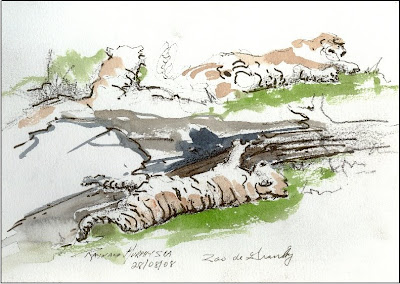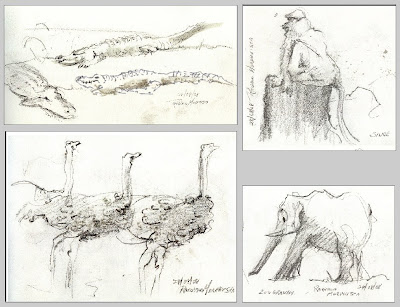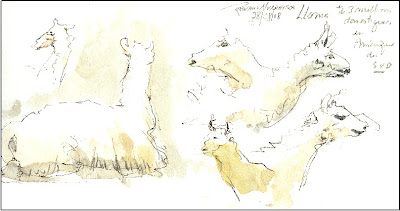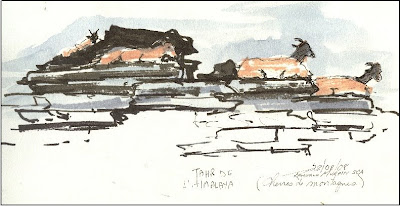 “Even the quickest sketch from life is better than a tickled-up drawing from a photograph.” Victor Ambrus in the magazine The Artist, September 2008.
“Even the quickest sketch from life is better than a tickled-up drawing from a photograph.” Victor Ambrus in the magazine The Artist, September 2008.Last summer my friends and I drew at Granby Zoo near Montreal. It was my first attempt at sketching animals on the spot other than drawing my dog. The experience proved so stimulating and challenging that I later visited the Saint-Laurence Valley Natural History Ecomuseum in the West Island a few days later for more fun sketching.
 Abandon and start another
Abandon and start anotherIf you are at your first experience drawing animals at the zoo do not expect them to pose for you for extended periods. Some species, the tiger or lion for example, will lounge quite motionless for an extended period. Most animals won’t however. If you are patient they will sometimes return to the same stance at some point. The strategy I use (and one mentioned also by Victor Ambrus in his article) is that I abandon a sketch when an animal moves away and I start another one somewhere else on the page. If the first animal returns to its position I return to the first drawing. Later I may add shading or reinforce certain key elements from memory.
I find it useful to include whenever possible some element of the animal’s habitat as in the scene of the Himalayan Tahrs. Not only do the stones on which the animals are resting situate them in their natural environment, but the large stones and the shapes surrounding them may also serve as a reference relative to the size of the animal. Close observation and comparison of both positive and negative shapes will help improve accurate rendering.
 Concentrate on shapes not what you think you “know” about the animal
Concentrate on shapes not what you think you “know” about the animalConsciously or unconsciously there is a struggle in an artist’s mind when drawing a very familiar object, person, plant or animal for example. One is sometimes wrongly influenced by drawing what one “knows” rather than what one “sees”. When drawing the animals at the zoo, I had to really concentrate on drawing the shapes in front of me and not fall into the trap of “filling in” what I “knew” about the animal. This was especially true when drawing the elephants. I am so familiar with the animated “Disney elephants” that I feel that some of my elephant drawings are surprisingly similar to renditions of Dumbo the Elephant in the film of the same name.
 Equipment
EquipmentWhen drawing animals you will be moving from site to site. Therefore, I strongly suggest that you bring with you only the essentials. Leave your tripod and heavy easels at home. Also, I found it very useful to carry some of my drawing equipment in a belt purse. Since every moment is precious and speed of execution is essential it is important to have an array of pencils pre-sharpened. Benches are not always available therefore it is a good idea to bring with you a small folding seat or stool. Although choice of paper is personal, I recommend that you use professional archival materials at all times even when “sketching”. Some of my successful first attempts at animals were done on thin paper. These drawings were later not properly fixed and now are ruined. Moreover, who knows if your “quick sketch” will merit “framing”?
“The more I observe, the more I realize how little I see, and I remember the incredible ability that we humans have to interpret and recompose the world as we wish.” Denis Clavreul in Dreaming of Africa.
Technical note on materials: Most drawings were done in Watercolor Field Book by Pro Art and Nature Sketch book by Pentalic. Graphite pencils, Cretacolor Nero pencils and Copic Permanent Markers were used. Color was added with Isabey Petit Gris brushes using Fragonard and Sennelier half-pan watercolors. All these supplies can be found at Art Tec in Montreal.
Raynald Murphy sca
Technical note on materials: Most drawings were done in Watercolor Field Book by Pro Art and Nature Sketch book by Pentalic. Graphite pencils, Cretacolor Nero pencils and Copic Permanent Markers were used. Color was added with Isabey Petit Gris brushes using Fragonard and Sennelier half-pan watercolors. All these supplies can be found at Art Tec in Montreal.
Raynald Murphy sca










Aucun commentaire:
Enregistrer un commentaire